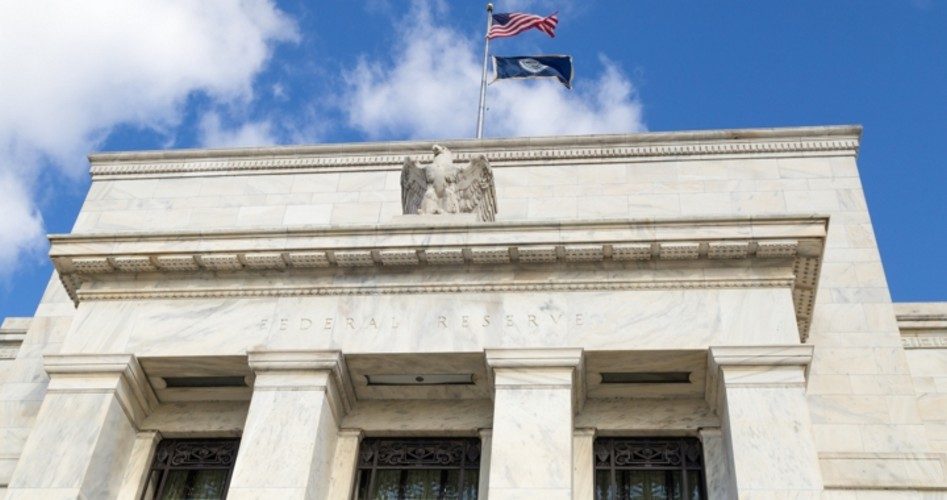
With the Board of Governors of the Federal Reserve likely to raise overnight bank lending rates by one quarter of one percent on Wednesday — its second increase in that rate this year and the sixth in the last 18 months — observers are increasingly concerned that those increases may throttle Trump’s roaring economy just as it’s beginning to hit its stride.
Some are dusting off the hoary maxim that “just when the party is getting started, the Fed takes the punch bowl away.” Others are expressing concerns about something called an “inverted yield curve” — a phenomenon which has preceded each of the last seven recessions.
Amy Scott, writing in Marketplace, summed up the challenge facing the board:
The Federal Open Market Committee begins its two-day meeting today to talk interest rates. The Fed is expected to raise its target rate by a quarter of a point for the second time this year [tomorrow]. And with unemployment reaching a new low last month and inflation creeping up, analysts expect officials to keep raising rates throughout the year.
If short-term yields keep rising, that could lead to what’s called an inverted yield curve, when short-term term rates are higher than long-term borrowing costs.
First, Scott is conflating inflation with price increases. Second, she is likely referring to the latest CPI numbers and not the Fed’s preferred measure of price increases, the PCE index.
Inflation has already occurred. The Fed created billions of digital dollars when it bailed out the big banks following the real estate collapse in 2007-2008. In fact, its balance sheet is so massive — over $4 trillion — that it is slowly beginning to sell off some of those reserves.
Price increases are the result of the previous inflation. Those price increases have been held in check largely because banks have been, until recently, unable or unwilling to lend out their residual capital. They have been content to keep their excess reserves encamped with the Fed, which has been paying them a low but predictable and risk-free rate of return.
The CPI accelerated in May to the fastest pace in more than six years, according to a Labor Department report released on Tuesday, rising 0.2 percent from April and 2.8 percent from a year ago. This is serving, according to many commentators, as justification for the Fed’s continual raising of short term rates. But a closer look at the Fed’s preferred measure of inflation, called the “annual core PCE” price index [personal consumption expenditures, excluding food and fuel], reveals year-over-year price increases of 1.8 percent.
But with the Fed determined to head off what it perceives as incipient inflation (which it caused), it is likely to continue to raise overnight rates steadily. Its belief is that the massive U.S. economy can be managed by its board of “experts” more effectively than can individual consumers voting with their dollars. That is the hubris of Keynesianism which is the Fed’s core operating manual.
What some are concerned about is that, in its determination to “get ahead of inflation,” it may tip the economy into recession in the process. Enter concerns about the “inverted yield curve” — a phenomenon when short term interest rates paid on U.S. Treasury bills rise above the rates paid on longer-term bills and notes. Right now the “spread” — the difference between two-year rates and 10-year rates — is 45 basis points (a basis point is one one-hundredth of a percent), down from 125 basis points just a year ago, and the lowest seen in years. As Justin Lahart, writing in The Wall Street Journal, noted: “This is a longstanding signal that a recession is coming.”
But is it? There have been false positives, as Goldman Sachs economist Jan Hatzius pointed out. An inverted yield curve “isn’t the cause of recessions so much as the result of the Fed trying to keep the economy from overheating.” In other words, recessions are more the result of the Fed’s meddling than the natural business cycle operating without outside interference.
The Cleveland Fed is approaching the matter much more calmly. Its internal calculation of the chances of a recession occurring in the next 12 months is a scant 13.4 percent, down from 13.8 percent last month. That’s less than once chance in seven.
Investors and informed citizens are wise to continue to monitor the behaviors and decisions of the Fed’s Board of Governors. But they should not be concerned about a recession starting anytime soon. The next raise of overnight rates scheduled for Wednesday will likely have little measurable impact on the roaring Trump economy.
Image: AdamParent via iStock / Getty Images Plus
An Ivy League graduate and former investment advisor, Bob is a regular contributor to The New American magazine and blogs frequently at LightFromTheRight.com, primarily on economics and politics. He can be reached at [email protected].



